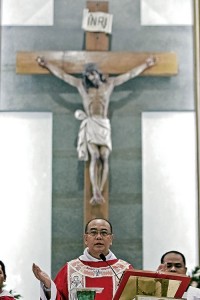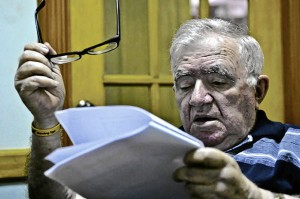Editor’s note: Below are excerpts from the 145th Discurso de Apertura (Opening Lecture) to welcome the new academic year of the 400-year-old University of Santo Tomas last June 6 at the UST Santisimo Rosario Church. The lecture, “Facebook Flashback: The Archives and the Story of the University (of Santo Tomas),” was delivered by Regalado Trota José, UST archivist and commissioner of the National Commission for Culture and the Arts.

José also showed documents from the archives to clarify certain episodes in UST history and correct a number of misconceptions, such as the alleged mistreatment that national hero José Rizal received from the Dominicans as supposedly gleaned from the poor grades he got as a UST student.
THE UST Archives is one of the least known, least visited, and quietest places in the university. It is one of the least known, yet it contains the very soul of the university: the documents accumulated through 400 years that bear witness to UST’s history.
It is one of the least visited because, somehow, few people are interested in researching on the past. It is one of the quietest places in school because those who come here—a significant number of whom are foreigners—work as if in a trance as they track down leads on their various research projects.
Indeed, the archives, with its wealth of material documenting social networks and its accumulation of yearbooks and memorabilia, is yesterday’s equivalent to today’s Facebook. 
The archives continues to accumulate files, yearbooks and documents, so like FB it is continually updated. At the same time, it allows the visitor to burrow into the past, whether it be the recent quadricentennial events or the purchase of land for the initial Colegio site 400 years ago.
My task this morning is to present to the UST community a history of its alma mater lovingly prepared by no less than its archivist of 50 years, Fr. Fidel Villarroel, OP. By some stroke of Providence, Fr. Fidel spoke at this same podium at the opening of school year 1971-1972, honoring one of UST’s finest alumni, Fr. José Burgos. Now, exactly 40 years later, he is the one being honored.
Tabulation of grades

No, I will not reduce 400 years of history into 20 minutes. That is for all of us to read and savor later. Instead, I thought it best to present four sections from Fr. Fidel’s history . . .
The four sections I will present deal with: 1) the indio students in the 1770s; 2) the title “Royal”; 3) Rizal’s grades in UST; and 4) the university church where we are gathered.
Most biographers of Rizal paint a bleak picture of his stay at UST. An examination of the records at the archives, however, presents a more balanced view. All of this has been presented by Fr. Fidel Villarroel, OP, in his book “Jose Rizal and the University of Santo Tomas” (1984), with so much more enriching detail and context. Thus I will just present a tabulation of his grades.
Grades of Rizal in UST (1877-1882)
Preparatory Course of Theology and Law (1877-1878)
Cosmology—Sobresaliente [Excellent; equivalent grade: 1.0]
Metaphysics—Sobresaliente [Excellent: 1.0]
Theodicy—Sobresaliente [Excellent: 1.0]
History of Philosophy—Sobresaliente [Excellent: 1.0]
Preparatory Course of Medicine
(1878-1879)
Advanced Physics—Aprovechado [Very Good: 1.5]
Advanced Chemistry—Sobresaliente [Excellent: 1.0]
Advanced Natural History—Aprovechado [Very Good: 1.5]
1st Year of Medicine (1878-1879)
Note: Rizal was one of four allowed out of 28 to take these courses simultaneously with those above, which was highly irregular, but it reveals the Dominicans’ recognition of their students’ intellectual preparation.
General Anatomy and Histology—Bueno [Good: 2.0]
Descriptive Anatomy—Bueno [Good: 2.0]
Exercises of Osteology and Dissection—Bueno [Good: 2.0]
2nd Year of Medicine (1879-1880)
General Anatomy and Histology II—Bueno [Good: 2.0]
Descriptive Anatomy II—Bueno [Good: 2.0]
Exercises of Dissection—Bueno [Good: 2.0]
Physiology, Private and Public Hygiene—Bueno [Good: 2.0]
3rd Year of Medicine (1880-1881)
General Pathology, Its Clinic, and Pathologic Histology—Aprobado [Passed: 3.0]
Therapeutics, Medical Matter and Art of Prescribing—Sobresaliente [Excellent: 1.0]
Surgical Anatomy, Operations, External Medical Applications and Bandages—Bueno [Good: 2.0]
4th Year of Medicine (1881-1882)
Medical Pathology—Notable [Very Good: 1.5]
Surgical Pathology—Notable [Very Good: 1.5]
Obstetrics, Sicknesses of Women and Children—Notable [Very Good: 1.5]
Siphilography—Notable [Very Good: 1.5]
Rizal not discriminated against
Summing up, in the 21 subjects taken in the university, Rizal obtained six Sobresaliente or Excellent, six Notable or Aprovechado or Very Good, eight Bueno or Good, and one Aprobado or Passing Grade. On the basis of these records, Fr. Fidel poses the following seven considerations:
1) Rizal was a good student, above average, though not excellent; but none of his classmates were excellent either. Rizal was not as gifted for Medicine as he was for the Letters and Arts.
2) In Madrid, his medical grades were the same or a little lower.
3) He is not on record as having ever complained about his grades in Santo Tomas, while he did complain about those he received in Madrid.
4) He was never discriminated against in Santo Tomas; on the contrary, he was favored with a dispensation which few students received.
5) Racial discrimination did not exist in his class, as shown by the fact that all his Spanish classmates fell by the roadside one by one in the course of four years.
6) In the fourth and last year in Santo Tomas, only seven students remained [out of the original batch of 24], and Rizal was one of them.
7) And he ended that year in second place.
We then must examine the motives and methodology of those other Rizal scholars to understand why they wrote as they did.

